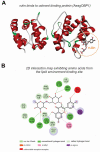Methanolic Extracts of Chiococca alba in Aedes aegypti Biorational Management: Larvicidal and Repellent Potential, and Selectivity against Non-Target Organisms
- PMID: 36501335
- PMCID: PMC9735851
- DOI: 10.3390/plants11233298
Methanolic Extracts of Chiococca alba in Aedes aegypti Biorational Management: Larvicidal and Repellent Potential, and Selectivity against Non-Target Organisms
Abstract
The use of formulations containing botanical products for controlling insects that vector human and animal diseases has increased in recent years. Plant extracts seem to offer fewer risks to the environment and to human health without reducing the application strategy's efficacy when compared to synthetic and conventional insecticides and repellents. Here, we evaluated the potential of extracts obtained from caninana, Chiococca alba (L.) Hitchc. (Rubiaceae), plants as a tool to be integrated into the management of Aedes aegypti, one of the principal vectors for the transmission of arborviruses in humans. We assessed the larvicidal and repellence performance against adult mosquitoes and evaluated the potential undesired effects of the extracts on non-target organisms. We assessed the susceptibility and predatory abilities of the nymphs of Belostoma anurum, a naturally occurring mosquito larva predator, and evaluated the C. alba extract's cytotoxic effects in mammalian cell lines. Our chromatographic analysis revealed 18 compounds, including rutin, naringin, myricetin, morin, and quercetin. The methanolic extracts of C. alba showed larvicidal (LC50 = 82 (72-94) mg/mL) activity without killing or affecting the abilities of B. anurum to prey upon mosquito larvae. Our in silico predictions revealed the molecular interactions between rutin and the AeagOBP1 receptor to be one possible mechanism for the repellent potential recorded for formulations containing C. alba extracts. Low cytotoxicity against mammalian cell lines reinforces the selectivity of C. alba extracts. Collectively, our findings highlight the potential of C. alba and one of its constituents (rutin) as alternative tools to be integrated into the management of A. aegypti mosquitoes.
Keywords: alternative insecticides; botanical pesticides; caninana plants; molecular docking predictions.
Conflict of interest statement
The authors declare no conflict of interest.
Figures





References
-
- Soares I.M., Ribeiro M.F., da Costa O.J., de Souza É.E., Aguiar A.A., Barbosa R.S., Alvim T.C., Ascêncio S.D., Aguiar R.W.S. Application of a Degreasing Process and Sequential Ultrasound-Assisted Extraction to Obtain Phenolic Compounds and Elucidate of the Potential Antioxidant of Siparuna guianensis Aublet. J. Med. Plants Res. 2017;11:357–366. doi: 10.5897/JMPR2017.6387. - DOI
-
- Mendes L.A., Martins G.F., Valbon W.R., Souza T.S., Menini L., Ferreira A., Silva Ferreira M.F. Larvicidal Effect of Essential Oils from Brazilian Cultivars of Guava on Aedes aegypti L. Ind. Crop. Prod. 2017;108:684–689. doi: 10.1016/j.indcrop.2017.07.034. - DOI
-
- Sousa R.M.O.F., Cunha A.C., Fernandes-Ferreira M. The Potential of Apiaceae Species as Sources of Singular Phytochemicals and Plant-Based Pesticides. Phytochemistry. 2021;187:112714. - PubMed
Grants and funding
- finnance code 01/Coordenação de Aperfeicoamento de Pessoal de Nível Superior
- 313455/2019-8; 427304/2018-0; 308576/2018-7/National Council for Scientific and Technological Development
- APQ-03771-18/Fundação de Amparo à Pesquisa do Estado de Minas Gerais
- FAPT-SESAU/TO-DECIT/SCTIE/MS_CNPQ/N° 01/2017/Tocantins State Foundation for Research Aid
- PROPESQ and PPGBIOTEC/UFT/GURUPI- Chamadas públicas para auxílio de tradução e/ou publicação de artigos cientificos/Federal University of Tocantins
LinkOut - more resources
Full Text Sources
Miscellaneous

